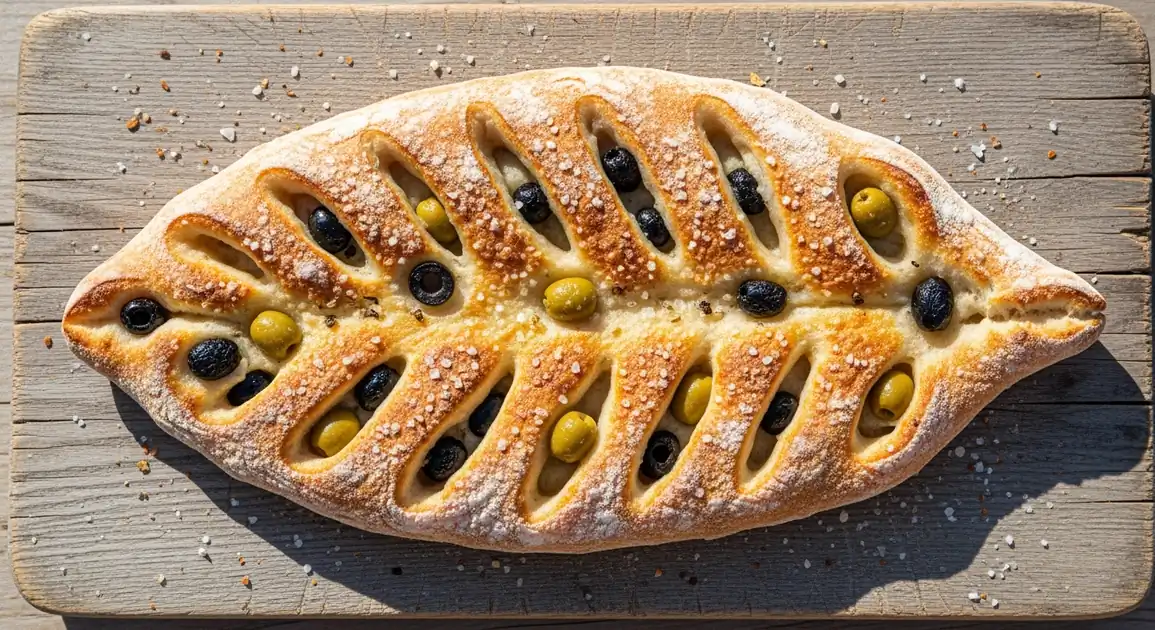Fougasse with Olives
Fougasse aux Olives

Description
Fougasse is a beloved bread throughout the South of France, particularly iconic in Provence. While variations exist regionally, the olive-studded version is quintessentially Provençal. It's a staple in boulangeries and markets, enjoyed year-round as a snack, appetizer, or accompaniment to meals.
Dietary Information
Serving information
Serving style
Served at room temperature. Typically torn by hand into pieces for sharing. Perfect for picnics, apéritifs, or alongside salads and soups.
Quick facts
Boulangeries often open early (e.g., 6 AM or 7 AM) and close around 7 PM or 8 PM, sometimes with a break for lunch.
Safety Tips
What to Look For
-
Crisp, golden-brown crust
Indicates it's freshly baked and not stale or undercooked.
-
Appears freshly baked (check bakery's schedule if possible)
Bakeries often bake multiple times a day; fougasse bought soon after baking is best.
-
Clean bakery environment
Ensure the bakery display cases, counters, and staff handling practices appear hygienic.
-
Pleasant smell of fresh bread and olives
A good indicator of fresh ingredients and proper baking.
What to avoid
-
Dry, hard, or pale crust
Signs of staleness or improper baking.
-
Fougasse left uncovered and exposed for long periods
While less critical than for moist foods, prolonged exposure can lead to staleness and potential contamination.
-
Visible signs of mold (rare on fresh bread)
Any visible mold means the bread should not be consumed.
-
Bakeries with poor overall cleanliness
General hygiene reflects on food safety standards.
Price information
Price range
Budget tips
- Prices vary by size and bakery location/reputation.
- Market stalls might offer slightly lower prices than high-end city bakeries.
- A whole fougasse is often large enough to share.
- Plain versions are usually cheapest.
Value indicators
- Good size for the price.
- Generous amount of olives or other toppings.
- Clearly freshly baked.
- Made with quality olive oil (evident in flavor).
Where to Find This Dish
Provence Region
Ubiquitous in boulangeries and markets across Provence (cities like Aix-en-Provence, Avignon, Nice, etc.).
Any Provençal town or village bakery/market
Morning, Afternoon
Southern France Markets
Outdoor markets are a great place to find various types of fougasse.
Cours Saleya (Nice), Place Richelme (Aix), Local village markets
Market days (usually mornings)
Vendor Tips
- Look for 'Artisan Boulanger' signs, indicating traditional craftsmanship.
- Don't hesitate to ask 'Quelle est la plus fraîche?' (Which is the freshest?).
- Try different variations if available (olives, herbs, lardons).
How to Order
Regional Variations
-
Fougasse Nature
(Fougasse Nature)
Plain version without olives, focusing on the olive oil dough and crust.
-
Fougasse aux Lardons
(Fougasse aux Lardons)
Includes small pieces of bacon (lardons) baked into the bread.
-
Fougasse aux Anchois
(Fougasse aux Anchois)
Features salty anchovy fillets pressed into the dough.
-
Fougasse au Fromage
(Fougasse au Fromage)
Incorporates cheese, often grated Emmental, Gruyère, or goat cheese.
-
Fougasse aux Herbes
(Fougasse aux Herbes de Provence)
Generously seasoned with Herbes de Provence blend (thyme, rosemary, savory, oregano, etc.).
-
Sweet Fougasse (Fougassette)
(Fougassette / Fougasse Sucrée)
A sweet version, often flavored with orange blossom water and sugar, typically found around Grasse or Nice.
Cultural context
History
Fougasse has ancient roots, believed to have originated in Roman times as 'panis focacius', a flatbread baked on the hearth (focus). It evolved across regions, with the Provençal version becoming distinctly associated with olive oil and often shaped to resemble a wheat stalk or leaf. Traditionally used by bakers to test oven temperature before baking loaves, it became a beloved bread in its own right, embodying the flavors of Southern France.
Local significance
Fougasse is a symbol of Provençal identity and its reliance on local ingredients like olive oil and olives. It represents conviviality and sharing.
Eating customs
- Sharing by tearing pieces off is customary.
- Often dipped in olive oil or eaten alongside tapenade.